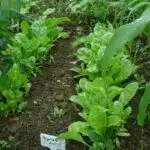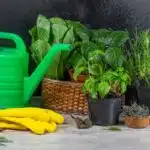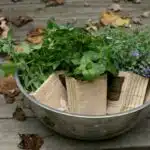Growing herbs indoors may seem impossible, but with the right tools and knowledge, it can be done! Many people are surprised to learn that they can not only grow herbs indoors in a sunny windowsill, but they can also do so with ease. With this guide, you’ll find out how to become a master at growing herbs indoors.
As a specialist in botany and gardening, I have seen many people try and fail—but it doesn’t have to be that way. In fact, if you just follow my simple instructions, you will be able to join the elite ranks of people who can successfully grow herbs indoors on a sunny windowsill. All it takes is a little bit of know-how and dedication.
You may think that caring for your own indoor herb garden would demand too much effort or attention, but I promise you that it does not! In fact, with the right information and tools, growing herbs indoors on a sunny windowsill can provide an incredibly rewarding experience as you work together with nature to create something beautiful and useful. Plus, you’ll get plenty of satisfaction from knowing that by growing your own herbs indoors you are helping yourself while also serving others around you.
Identify The Best Herbs To Grow Indoors
It’s ironic that growing herbs indoors on a sunny windowsill can be so difficult, but with the right knowledge and guidance, it’s possible! As a specialist in botany and gardening, I’m here to provide you with the best tips for achieving success in your herb-growing endeavor.
First things first: identify the best herbs to grow indoors. This can be tricky, as many herbs require a lot of sun and heat – something that isn’t always easy to come by when you’re limited to an indoor environment. Luckily, there are some herbs that thrive in partial sunlight or even no sunlight at all – like parsley, rosemary, thyme, oregano, basil and dill. Many of these are also great for cooking purposes!
Once you’ve identified which herbs you want to cultivate inside your home, it’s important to consider what type of container will work best. Most herbs need lots of drainage; therefore, make sure to pick a pot with plenty of holes in the bottom. Additionally, bear in mind that many types of herbs need plenty of room for their roots to grow. If the pot is too small or shallow for your chosen herb variety then transplanting it into a larger pot is an option worth considering.
With the right kind of container and well-chosen varieties of herbs for your sunny windowsill garden you’ll be able to enjoy fresh homegrown flavors all year round!
Choose The Right Type Of Container
Choosing the correct container for growing herbs indoors on a sunny windowsill is an important part of cultivating these plants. Containers come in all shapes, sizes, and materials. It’s critical to consider each of these elements when selecting the right receptacle for your indoor herb garden.
When it comes to containers, be sure to pick one that’s suited to your particular herb’s needs. A specialist in botany and gardening knows how essential it is to consider both the size and type of container when selecting one for growing herbs indoors.
Here are some tips for picking the perfect pot:
- Size: Pick a container depending on how much space you have available on your windowsill. If you’re looking for an aesthetically pleasing feature in your home, opt for a larger pot with multiple plants inside; if you want something smaller and more compact, choose individual pots instead.
- Material: The material used for plant containers is also important; clay or terracotta pots provide good drainage and air circulation, while plastic pots are easier to maintain but don’t absorb as much heat from the sun as other materials do. Consider what would work best with your chosen herb species before deciding on a material.
By taking into account the size and material of your chosen container, you can ensure that your herbs will flourish indoors on their sunny windowsill!
Provide Adequate Drainage
Drainage is a critical component of cultivating herbs indoors on a sunny windowsill. As any specialist in botany or gardening could tell you, proper drainage is essential for healthy plants and prevents root rot. To achieve this, it’s important to pre-treat containers with bleach and provide adequate drainage holes.
When selecting the right type of container for your herb garden, make sure it has at least one hole in the bottom for draining away excess water. For example, decorative metal or ceramic planters may not have built-in drainage holes and will require you to drill one yourself. Additionally, if you’re using a pot without a drainage hole, be sure to line it with stones or pebbles before adding soil so that water can soak through them and out.
Finally, once you’ve prepared your container by drilling a hole in the bottom for drainage, it’s time to fill it with soil. Make sure to use an organic potting mix specifically designed for herbs since they require well-draining soil which helps reduce the risk of fungal diseases caused by overly moist conditions. With adequate drainage in place and quality soil added, your herbs should grow robustly on your sunny windowsill!
Pre-Treat Containers With Bleach
When growing herbs indoors, it’s essential to pre-treat containers with bleach before planting. This process is important as it ensures that any leftover bacteria and dirt in the container does not contaminate the plants and soil. A good rule of thumb for this step is to mix about one part bleach with nine parts water and then rinse the container thoroughly after submerging it in the mixture.
Using a bleaching agent like chlorine or sodium hypochlorite helps kill off any pathogens that may be present on the container, while also preventing any potential diseases from developing later on. Additionally, bleaching can help reduce the risk of pests infesting your plants, which could lead to stunted growth or even death.
Finally, pre-treating containers with bleach can give your herbs a better chance at thriving indoors over a long period of time, so make sure you don’t skip this step! With proper care and attention, your herbs should be able to thrive in their new home – but only if you take the appropriate precautions first. To ensure your herbs get off to a healthy start, fill their containers with potting soil next.
Fill The Containers With Potting Soil
Filling the containers with potting soil is like creating a blank canvas – you can use it as a foundation to prepare the perfect environment for your herbs. As a Specialist in botany and gardening, I’m always looking to maximize the potential of any growing space. For this step, choose a high-quality potting soil that drains well and contains essential nutrients like nitrogen and phosphorus. Make sure to mix in some organic matter, such as compost or perlite, for added aeration and moisture retention.
When filling up your containers, use enough soil so that it reaches about one inch below the rim. This will give your herbs plenty of room to grow their roots deep into the soil for optimal nutrition. Once your containers are filled, gently tap them on the side to release air pockets and level off any bumps or variations in the surface. Finally, water thoroughly until water starts dripping out of the bottom drainage holes – this will ensure that your herbs are planted in moist soil.
With this step completed, you’re ready to prepare the herbs for planting. But first, let’s make sure you know how much sun exposure they need by checking out our helpful guide on light requirements for indoor plants...
Prepare The Herbs For Planting
It may come as a surprise to many, but herbs can be grown indoors on a sunny windowsill with very little effort. In fact, according to the Home Gardeners Association, indoor herb gardens are quickly becoming one of the most popular home gardening activities in America. With the following steps, you’ll be able to enjoy fresh herbs from your own windowsill!
When preparing the herbs for planting, there are six things to keep in mind:
- Select the types of herbs that you want in your garden;
- Choose a variety that is suited for growing indoors;
- Obtain either small plants or seeds;
- Make sure the container is deep enough and well-drained;
- Fill the container with potting soil; and
- Prepare the herbs for planting.
The best way to prepare herbs for planting is to start with either potted plants or seeds. If you choose potted plants, simply remove them from their pots and place them into your chosen containers. If you choose seeds, they should be placed into damp potting soil one inch apart and lightly covered with more soil before being watered thoroughly. This will ensure that each seed receives adequate moisture for germination. Once planted, it’s important to check regularly for weeds and water as needed.
Now that you have all of your materials ready, it’s time to plant the herbs in their containers! With just a few simple steps, you can have fresh herbs growing on your windowsill in no time at all!
Plant The Herbs In The Containers
The seventh step in growing herbs indoors on a sunny windowsill is to plant them in the appropriate containers. It’s important to choose the right sized pot for your herb plants, as each variety has different root depths and needs for space. Smaller pots are best for shallow-rooted species like chives, oregano, and mint, while deeper-rooted herbs such as sage, rosemary, thyme and parsley will require larger containers. Be sure to fill the containers with well-draining potting mix and make sure you leave some room at the top of the container so that you can water easily without spilling over.
After planting the herbs in their respective pots, it’s important to carefully water them according to their individual needs. Some herbs may need more frequent watering than others, so be sure to read up on the particular species that you have chosen before you begin. Additionally, an occasional misting of water can help keep indoor herbs healthy and happy.
Now that your herbs are thriving in their containers, it’s time to place them in a sunny windowsill where they will receive plenty of natural light throughout the day. Make sure that the containers are not too close together as overcrowding can lead to competition for resources such as sunlight and nutrients. Additionally, rotate your herb plants periodically if one side of your windowsill receives more sun than another so that all sides of your plants get even exposure to light.
Position The Containers In A Sunny Windowsill
Positioning the containers in a sunny windowsill is critical to growing herbs indoors. A windowsill that gets at least 6 hours of direct sunlight per day is ideal for most herbs. It’s also important to make sure it’s not too hot, as some herbs do better in cooler temperatures. To ensure your herbs get enough sun, you can either place them near a south-facing window, or rotate them throughout the day if you have multiple windowsills available.
In addition to getting adequate sunlight, it’s important to keep your containers elevated so that air is able to circulate and moisture doesn’t build up. If moisture accumulates, the herb roots can rot and cause plant death. You can use a shelf or rack specifically for plants, or simply raise the container off the sill with a few books or stones.
Once you’ve got the positioning sorted out, it’s time to start watering your herbs regularly. Aim for moist soil but not overly soggy—so check often and water as needed! By following these steps, you’ll soon be enjoying fresh herbs grown in your very own home!
Water Herbs Regularly
Watering herbs is like giving them a sip of life. Just as water is essential for sustaining human life, it is also essential to the successful growth of herbs indoors. As a specialist in botany and gardening, I believe that understanding how to properly water herbs is one of the most important steps in their care.
When watering your herbs, aim to keep the soil evenly moist but not soggy. The amount of water required will depend on how much natural light they receive as well as the size and type of container you’re using. To best gauge when they need more moisture, I recommend sticking your finger into the soil up to your first knuckle joint. If it’s dry, then you know it’s time for more water; if it’s damp or wet, then you can leave them be for a few days.
When providing additional moisture, do so slowly and evenly so that all parts of the soil inside the container have an opportunity to absorb some water. You may find that you’ll need to give them more frequent drinks during hotter months or when exposed to direct sunlight for extended periods of time. That being said, always make sure not to over-water your herbs; this can cause root rot or other diseases which can lead to permanent damage or death in extreme cases.
To ensure that your herbs remain healthy and vibrant indoors, it’s important to provide them with adequate hydration while avoiding overwatering at all costs. By taking the time to understand their needs and following these simple rules, you can rest assured knowing that your herbs will thrive on your sunny windowsill!
Fertilize The Herbs
Fertilizing herbs is like painting a picture – the ingredients are the paints, and the result can be lush and colorful. As a specialist in botany and gardening, I’m here to tell you that fertilizing your herbs is essential for keeping them healthy indoors.
When adding fertilizer, it’s important to distribute it evenly around the base of each herb. A balanced fertilizer is usually best when growing herbs indoors, as it will provide essential nutrients without overdoing it on any one element. Additionally, use a liquid fertilizer to supplement every two weeks or so while the plants are actively growing. This will help your herbs reach their full potential.
It’s also important to watch how much fertilizer you’re using, as too much can cause nutrient burn or even kill your plants. Make sure to follow the recommended dosage on your container or dilute accordingly before applying. With careful fertilizing and watering practices, your herbs should thrive in their sunny windowsill spot!
Prune The Herbs As Needed
Pruning herbs is an important part of growing them indoors on a sunny windowsill. It helps encourage healthy, strong growth and eliminates any dead leaves or stems. Additionally, it allows the herb to focus its energy on producing new growth, instead of trying to maintain old woody stems. When pruning herbs, be sure to cut back no more than one third of the plant at once so as not to shock it.
To begin pruning your herbs, start by removing any dead or dying leaves and stems first. This will help prevent disease from spreading and discourage pests from inhabiting the plant. Next, look for any stems that are too long or have become woody; these should be trimmed back to a few inches above a node (where new leaves emerge). Be sure not to remove too much foliage; this can weaken the plant’s ability to produce essential oils and other compounds that give herbs their flavor and aroma.
Finally, take some time to inspect your plants for pests such as aphids or mealybugs. These critters can quickly cause damage and spread disease if left unchecked. If you find any pests on your plants, use an insecticidal soap or neem oil spray to get rid of them before they cause further harm. With proper pruning techniques and pest control measures in place, you can ensure that your herbs stay healthy and productive indoors on a sunny windowsill!
Monitoring your plants for pest control is just as important as pruning them correctly; both practices work hand in hand towards achieving healthy indoor herb gardens with abundant harvests.
Monitor For Pest Control
A healthy herb garden starts with proper pest control. It’s essential to maintain a watchful eye on your herbs and take timely action to ensure they stay in perfect condition. Here’s what you need to do:
- Monitor the plants regularly for any signs of pests or diseases.
- Take prompt action by using natural methods or pesticide sprays, if necessary.
- Keep an eye out for any changes in the environment that might be causing problems.
- Look for droppings, webs, eggs, or other signs of pests.
As a specialist in botany and gardening, it is important to understand that pests can quickly cause damage to your herbs if not addressed promptly and appropriately. Keeping an eye out for pests and taking preventive measures will ensure that your herbs remain healthy and strong throughout their growth indoors on a sunny windowsill.
It is also important to take into account the environmental factors such as inadequate ventilation, too much light, or extreme temperatures which could contribute to pest infestation. Taking preventative steps like ensuring adequate airflow between plants and adding screens on windowsills can help avoid pest infestations due to environmental conditions.
By monitoring your herbs regularly and taking preventive measures against pest infestation, you can keep your herb garden looking lush and beautiful year-round. With these tips in mind, you’re well on your way to growing strong, healthy indoor herbs! Now let’s move onto watching for signs of disease…
Watch For Signs Of Disease
It’s the home stretch. Now that you’ve got your herbs growing healthily on a sunny windowsill, it’s time to keep an eye out for any signs of disease. Like an eagle scouting for prey, you should scan the plants regularly for any suspicious activity. Here are some tips to help you stay vigilant:
• Inspect leaves regularly for yellow or brown spots, or any other abnormal discoloration. • Monitor the soil moisture and check if the herbs need extra water or if they’re suffering from overwatering. • Look out for any wilting leaves or leaf drop due to lack of nutrients or sun exposure. • Examine the entire plant for evidence of insect damage such as small holes in leaves, webbing, and sticky residue on foliage.
As a botanist and gardener, I can’t emphasize enough how important it is to catch signs of disease early on before they start spreading throughout your herb garden. Catching them in time can mean saving hours of hard work and frustration, not to mention potential losses in yield due to wilting plants and rotting crops. The key is staying alert and being prepared with knowledge about proper plant care so that you can spot any abnormalities right away. With this strategy in place, you’re ready to move onto harvesting the herbs when they reach their peak flavor and nutritional value!
Harvest The Herbs
It’s time to reap the rewards of your labor! After diligently following all the steps outlined, you can now experience the joy of harvesting your herbs. Imagine taking a scissor and carefully snipping off fresh leaves from your windowsill-grown plants – what an achievement for any aspiring gardener!
As a specialist in botany and gardening, I must urge you to take caution when harvesting. It’s important not to pluck too much foliage, as it could compromise the health of the plant itself. You should aim to cut only one-third or one-fourth of the leaves at a single time, ensuring that some growth is left behind.
Moreover, make sure to remove any dead or discolored leaves before they start to spread disease to other parts of the plant. As soon as you’re done with harvest, replace these damaged parts with new ones that will help maintain growth and healthy development of your herbs. This way, your windowsill herb garden will be able to thrive for many years!
Replace The Herbs As Needed
Replacing herbs is an essential part of successful indoor herb gardening. By understanding the needs of your herbs, you can ensure they are replaced as needed and continue to thrive in your windowsill garden.
Take for example the sweet basil plant. Its leaves will begin to dry out over time and eventually lose their flavor, so you must replace it before this happens. To do this, simply cut off the top few inches of stem, leaving enough foliage on the stem for it to regrow quickly. Then repot it in fresh soil to give it a new lease on life!
Replacing herbs is not only important for keeping them healthy and vibrant, but also helps maintain a good balance in your windowsill garden. If one plant begins to dominate or take up too much space, replacing it with a different variety can help create diversity and encourage growth of other plants. For instance, if your parsley has grown taller than the rest of your herbs, try replacing it with some thyme or oregano instead!
It’s easy to keep your herb garden looking its best—simply replace old plants with new ones as necessary. With regular care and attention, you’ll always have fresh herbs growing on your sunny windowsill!
Frequently Asked Questions
What Is The Optimal Temperature For Growing Herbs Indoors?
Most herbs grow best in warm and sunny conditions, so growing them indoors on a sunny windowsill is a great option. To ensure that your herbs are getting the optimal temperature for growth, it’s important to be mindful of the temperatures that different herbs prefer. For instance, basil prefers warmer temperatures around 65-75°F, whereas parsley prefers cooler temperatures at 40-50°F.
To manage these temperature requirements, you’ll want to adjust the location of your potted herbs accordingly. Place the basil plants closer to the windowsill where they’ll receive more sun and warmth, whereas you may want to move the parsley further away from direct sunlight. Additionally, be sure to monitor your indoor air temperature regularly with either an indoor thermometer or temperature gauge.
As you get familiar with how your particular herbs react to certain indoor temperatures and light levels, you’ll be able to better tailor your environment to suit their needs. With just a little bit of extra care and attention to detail when it comes to temperature management, you can ensure that your herb garden is optimally set up for success!
What Is The Best Way To Prevent Over-Watering Herbs?
When it comes to growing herbs indoors, one of the most important things is to prevent over-watering. This is because too much water can lead to root rot and fungal diseases, which can quickly kill your plants. For this reason, it’s important to find the right balance when watering.
The best way to prevent over-watering is by using a potting mix that has good drainage. The mixture should be slightly damp but not wet. Additionally, don’t water your herbs from above and directly onto the leaves as this can cause mold and mildew growth. Instead, use a spray bottle or pour water at the base of the plant so that only the roots get wet.
Finally, make sure you’re regularly testing the soil moisture levels with your finger or a soil moisture meter. If the soil feels dry an inch below the surface, then it’s time to give them a drink. With these tips in mind, you’ll be able to maintain healthy herb plants without worrying about over-watering!
How Often Should Herbs Be Fertilized?
Fertilizing herbs is an essential part of growing them indoors. When done correctly, it can help ensure that your herbs get the nutrients they need to thrive. But how often should you fertilize? Let’s take a closer look at the best practices for fertilizing your herbs on a sunny windowsill.
First, it’s important to know that indoor plants require less fertilizer than outdoor plants because they grow more slowly in smaller pots. For most herbs, once-a-month fertilization is typically sufficient. However, you may need to adjust this frequency depending on the type of fertilizer you’re using and whether or not your herb is showing signs of nutrient deficiency.
If you are using a liquid fertilizer, you may need to increase the frequency of application. Solid fertilizers like granular or pellets can be applied less frequently as they release their nutrients slowly over time. Additionally, if your herb’s leaves are yellowing or curling, this could indicate that they are not getting enough nutrition and require more frequent fertilization.
To ensure your herbs have adequate access to nutrients and stay healthy, experiment with different types of fertilizer and observe how well your plants respond accordingly. Monitor the growth rate and health of your herbs carefully so that you can adjust your feeding schedule as needed for optimal results.
What Type Of Soil Should Be Used For Growing Herbs Indoors?
It is estimated that up to 80% of plants grown indoors are in need of additional fertilization. When growing herbs indoors on a sunny windowsill, the soil used must be carefully chosen. As herbs require well-drained soils, a loam or sandy loam soil with a pH of 6.5 to 7.3 is ideal for most herbs. The soil should also be supplemented with organic matter such as compost or aged manure, to increase the nutrient content and improve drainage.
Organic matter helps aerate the soil, allowing oxygen and water to penetrate more easily and retain its structure for better root development. Adding mulch over the soil can also help keep it moist and reduce water loss due to evaporation. Additionally, when planting into containers, it is essential that they have good drainage holes as this will reduce the risk of root rot caused by waterlogged conditions.
Herbs grown indoors on sunny windowsills need plenty of sunlight to thrive; at least six hours per day should suffice. If possible, they should be rotated frequently so that each herb receives an equal amount of light throughout the growing season – this will ensure abundant growth and yields during harvest time! With careful attention to detail when selecting the right type of soil, adding organic matter and providing plenty of sunlight, it is possible for gardeners to successfully cultivate flavorful herbs in their sunny windowsills all year round.
Are There Any Precautions To Take When Harvesting Herbs?
Are you curious about the best ways to harvest herbs indoors? Growing herbs can be a rewarding experience, but it is important to take certain precautions to ensure that your plants are harvested safely. In this article, we will explore the steps you should take when harvesting herbs from a sunny windowsill.
First and foremost, it is important to understand which herbs should be harvested and when. Some herbs can be cut as soon as they reach maturity, while others need more time before they are ready for harvesting. It is also important to note that some herbs may need multiple harvests for maximum flavor and health benefits. As such, it is essential to research the specific herb you are growing in order to determine the best harvesting technique and timing.
Once you have determined when an herb should be harvested, there are several things to keep in mind before cutting or pulling the plant out of the soil. To prevent damaging the plant’s roots, use a sharp pair of scissors or pruning shears instead of pulling it out with your hands. Additionally, make sure not to remove too much of the stem as this can interfere with its growth rate. Finally, always harvest on a dry day in order to reduce any risk of bacteria or mold developing on the herb afterwards.
Harvesting herbs correctly requires careful observation and preparation – but getting it right will provide you with delicious flavors and aromas! By taking these steps into account before harvesting your indoor-grown herbs, you can ensure that your plants will remain healthy and vibrant throughout their lifetime.
Conclusion
Growing herbs indoors can be a rewarding experience and bring the fresh flavor of herbs to your kitchen year round. With just a little bit of effort, you can have an abundant harvest of herbs. The most important factor to take into consideration when growing herbs indoors is the temperature. When kept in temperatures between 50-70°F, herb growth will be optimal.
Over-watering is one of the biggest issues when it comes to growing herbs indoors, so ensure that the soil has time to dry out between waterings. Fertilizing should also be done every two weeks with a liquid fertilizer that is tailored for houseplants. The soil should be light and well draining, as this will help prevent root rot and other diseases.
When harvesting your indoor herbs, take caution not to over harvest as this could lead to stunted growth and poor health. Interesting statistic – did you know that rosemary was found to have three times more antioxidant capacity when grown indoors versus outdoors? Taking care of your indoor herb garden does require some effort but with the right conditions in place, you’ll reap the rewards of having fresh herbs all year round!





























